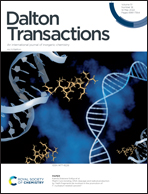Syntheses, rearrangements, and structural analyses of unsaturated nitrogen donor ligands derived from diphenyldiazomethane and the chiral rhenium Lewis acid [(η5-C5H5)Re(NO)(PPh3)]+†
Abstract
Diphenyldiazomethane and a labile chlorobenzene complex of [(η5-C5H5)Re(NO)(PPh3)]+ BF4− react to give the η1 adduct [(η5-C5H5)Re(NO)(PPh3)(NNCPh2)]+ BF4− (73%). When this is conducted in the presence of copper powder, a 3-phenyl-1H-indazole complex derived from carbon–hydrogen bond activation, [(η5-C5H5)Re(NO)(PPh3)(![[upper bond 1 start]](https://www.rsc.org/images/entities/char_e010.gif) N
N![[double bond, length as m-dash]](https://www.rsc.org/images/entities/char_e001.gif) C(Ph)
C(Ph)![[lower bond 1 start]](https://www.rsc.org/images/entities/char_e012.gif) C
C![[double bond, length as m-dash]](https://www.rsc.org/images/entities/char_e001.gif) CHCH
CHCH![[double bond, length as m-dash]](https://www.rsc.org/images/entities/char_e001.gif) CHCH
CHCH![[double bond, length as m-dash]](https://www.rsc.org/images/entities/char_e001.gif) C
C![[lower bond 1 end]](https://www.rsc.org/images/entities/char_e013.gif) N
N![[upper bond 1 end]](https://www.rsc.org/images/entities/char_e011.gif) H)]+ BF4−, is obtained (65%). Subsequent reaction with NaOCH3 gives indazolyl complex (η5-C5H5)Re(NO)(PPh3)(
H)]+ BF4−, is obtained (65%). Subsequent reaction with NaOCH3 gives indazolyl complex (η5-C5H5)Re(NO)(PPh3)(![[upper bond 1 start]](https://www.rsc.org/images/entities/char_e010.gif) N
N![[lower bond 1 start]](https://www.rsc.org/images/entities/char_e012.gif) C
C![[double bond, length as m-dash]](https://www.rsc.org/images/entities/char_e001.gif) CHCH
CHCH![[double bond, length as m-dash]](https://www.rsc.org/images/entities/char_e001.gif) CHCH
CHCH![[double bond, length as m-dash]](https://www.rsc.org/images/entities/char_e001.gif) C
C![[lower bond 1 end]](https://www.rsc.org/images/entities/char_e013.gif) C(Ph)
C(Ph)![[double bond, length as m-dash]](https://www.rsc.org/images/entities/char_e001.gif) N
N![[upper bond 1 end]](https://www.rsc.org/images/entities/char_e011.gif) ) (85%), derived from NH deprotonation and a 1,2-rhenium shift. Crystal structures of the three new complexes are determined. DFT calculations are used to probe the mechanism of the 1,2-shift and energetics of alternative Re–N rotamers and linkage isomers, and assign bond orders and dominant resonance formulations.
) (85%), derived from NH deprotonation and a 1,2-rhenium shift. Crystal structures of the three new complexes are determined. DFT calculations are used to probe the mechanism of the 1,2-shift and energetics of alternative Re–N rotamers and linkage isomers, and assign bond orders and dominant resonance formulations.
![Graphical abstract: Syntheses, rearrangements, and structural analyses of unsaturated nitrogen donor ligands derived from diphenyldiazomethane and the chiral rhenium Lewis acid [(η5-C5H5)Re(NO)(PPh3)]+](/en/Image/Get?imageInfo.ImageType=GA&imageInfo.ImageIdentifier.ManuscriptID=D2DT00890D&imageInfo.ImageIdentifier.Year=2022)


 Please wait while we load your content...
Please wait while we load your content...